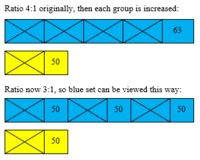Suppose there were, say, 1000 marbles to begin, 800 blue and 200 yellow (so 80% are blue). Adding 63 blue and 50 yellow we have 863 blue and 250 yellow for a total of 1113 marbles. Now the blue marbles are 863/1113, approximately 77% of the whole. We want 75% so lets try instead 2000 marbles, 1600 blue and 400 yellow. Adding 63 blue and 50 yellow we have 1663 blue and 450 yellow for a total of 2113 marble. Now the blue marbles are 1663/2113, approximately 78%.
Oop! That's going the wrong way! We want to go down from 77% to 75%, not up. So instead of doubling, lets try halving. Suppose there are 500 marbles, 400 blue, 100 yellow. Adding 63 blue, 50 yellow gives 463 blue, 150 yellow for a total of 613. Now the blue marbles are 463/613, approximately 75.5%.
Alright! That's in the right direction and pretty close to 75%. Let's continue, trying 450 marbles, 360 blue, 90 yellow. Adding 63 blue and 50 yellow marbles gives 423 blue and 140 yellow for a total of 563 marbles. Now the blue marbles are 423/563, approximately 75.1%. We just need to go down a little more!
Let's try 440 marbles, 352 blue, 88 yellow. Adding 63 blue and 50 yellow gives 415 blue and 138 yellow for a total of 553 marbles. Now the blue marbles are 415/553, approximately 75.09%. That's very close but not exactly 75%.
Try 430 marbles, 344 blue, 86 yellow. Adding 63 blue and 50 yellow gives 407 blue and 136 yellow for a total of 543 marbles. Now the blue marbles are 407/543, approximately 74.9%. That's too low so now we know the answer is between 430 and 440 marbles, initially, so between 543 and 553 after the new marbles are added.
Now you can try 435 to see if that is too high or too low or "just right". If it is "just right" you are done. If it is too high, try every number between 430 and 435 (there are only four such numbers). If it is too low try every number between 435 and 440.
That's how this can be done without using algebra. If we could use algebra we might let M represent the total initial number of marbles. Then there are 0.8M blue marbles and 0.2M yellow marbles. Adding 63 blue and 50 yellow marbles give 0.8M+ 63 blue and 0.2M+ 50 yellow marbles for a total of M+ 113 marbles. The ratio of blue marbles to all marbles is (0.8M+ 63)/(M+ 113)= 0.75.
Multiply both sides by M+ 113 to get 0.8M+ 63= 0.75(M+ 113)= 0.75M+ 84.75. Subtract 0.75M and 63 from both sides to get 0.05M= 21.75. Finally, divide both sides to get M= 435. That was a lot faster and is a good reason to learn algebra!


